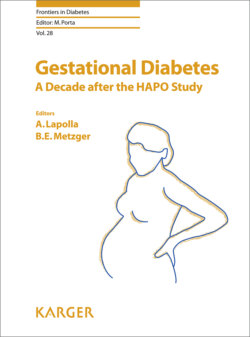Читать книгу Gestational Diabetes - Группа авторов - Страница 26
На сайте Литреса книга снята с продажи.
Lipid Metabolism
ОглавлениеFreinkel [13] demonstrated in animal models that fasting during pregnancy caused glucose levels and levels of gluconeogenic amino acids to fall more rapidly, and ketones to increase more rapidly, than in the nonpregnant state, a phenomenon he labeled “accelerated starvation”. This rapid transition from glucose to lipid as a fuel source during fasting was confirmed in human pregnancies [46]. All of these changes enhance lipolysis, increasing circulating fatty acids, favoring maternal reliance on lipid utilization for energy, and sparing glucose, amino acids and to some extent fatty acids for transfer to the fetus. Despite increased reliance on lipids as an energy source, the pregnant woman accumulates approximately 3.3 kg of additional fat stores. Freinkel et al. [47] explained this apparent contradiction by demonstrating that, when a meal is ingested by a pregnant woman after a period of fasting, a larger proportion of ingested glucose is converted into circulating triglyceride which does not cross the placenta and can be retained by the mother as fat accretion. Furthermore, the insulin resistance of pregnancy results in higher glucose levels after eating despite higher insulin levels that act to suppress glucagon release, allowing greater glycogen storage in the liver. He labeled this phenomenon “facilitated anabolism” [47].
Changes in lipid metabolism begin in early pregnancy. In a longitudinal study of normal pregnant women, plasma triglyceride levels rose, on average, by 39% and cholesterol by 26% between weeks 6 and 12 of gestation [48]. By term, triglyceride and VLDL cholesterol levels have increased by 2.5 times and LDL cholesterol by 1.6 times [49]. The increase in cholesterol levels may reflect the needs of the placenta for steroid synthesis. The increase in hepatic synthesis of lipoproteins is mediated by the increased estrogen levels of pregnancy, while decreased clearance is attributed to lowered activity of lipoprotein lipase and hepatic lipase [50].
Approximately 1 g/day of hPL is secreted at term, making it the most copious peptide hormone in pregnancy. One effect of hPL is to increase lipolysis in adipocytes leading to increased availability of free fatty acids (FFAs), which can be used to meet maternal energy needs as well as for fetal construction [51]. The decreased adiponectin levels observed in late pregnancy also favor increased lipolysis [52]. The insulin resistance of pregnancy applies to lipid metabolism as well as glucose metabolism, favoring lipolysis and leading to increased availability of triglycerides, which can be hydrolyzed by placental lipases to FFAs which can then cross the placenta to become available to the fetus [52]. This mechanism may be in play when mothers with gestational or preexisting diabetes, despite excellent glucose control, deliver large babies. The presence of large amounts of FFAs, in conjunction with fetal hyperinsulinemia, may lead to increased lipogenesis and neonatal adiposity, and subsequent childhood obesity [52].
